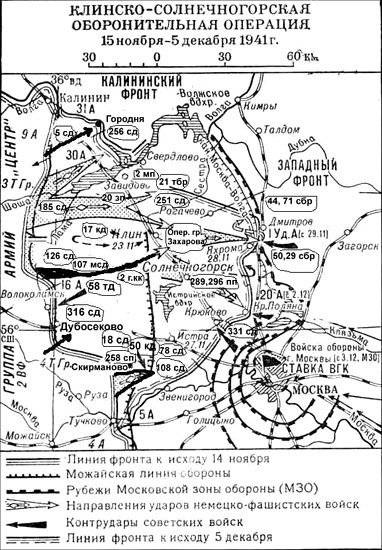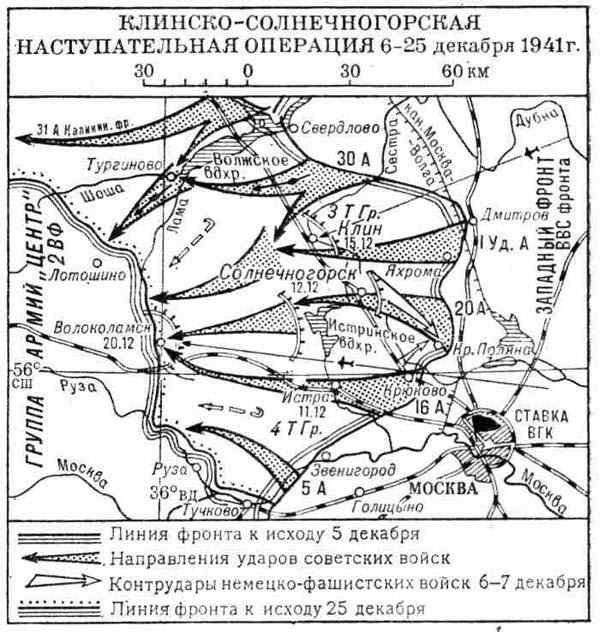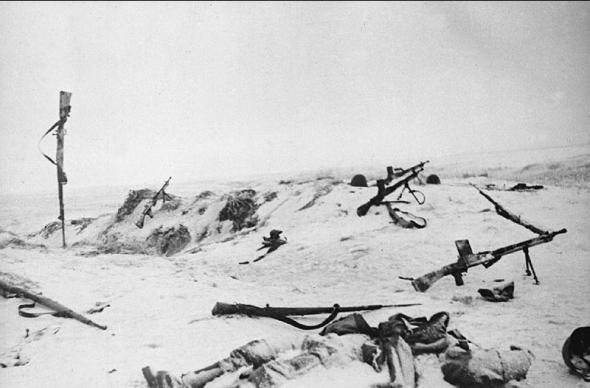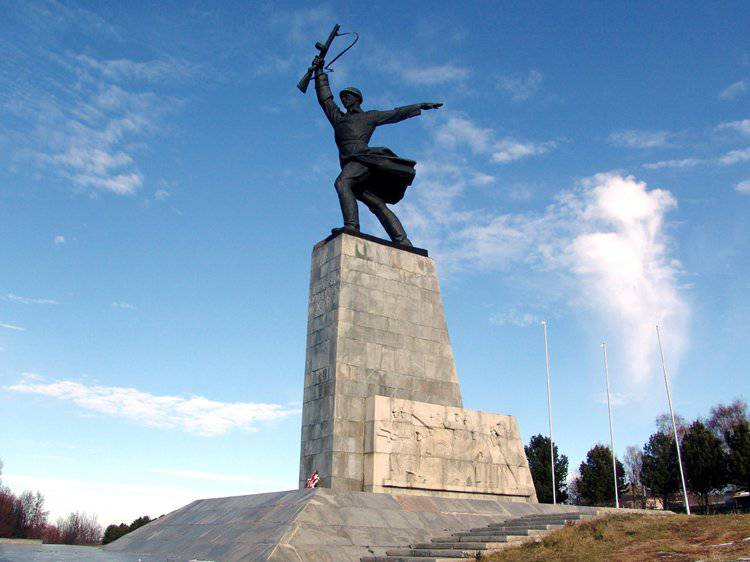To the 70 anniversary of the counter-offensive. Klin-Solnechnogorsk operation
 After the failure of the October offensive on the capital of the USSR, the German command decided to prepare a new strike by the troops of Army Group Center to encircle and capture Moscow by sweeping it from the north and south.
After the failure of the October offensive on the capital of the USSR, the German command decided to prepare a new strike by the troops of Army Group Center to encircle and capture Moscow by sweeping it from the north and south. For the strike north of Moscow, the 3rd and 4th were concentrated on the Kalinin-Volokolamsk-Ruza front tank groups under the command of G. Reinhardt and E. Göpner (7 tank, 3 motorized and 4 infantry divisions). From the side of the USSR, the 30th Army under the command of Major General D. D. Lelyushenko and the 16th Army under the command of Lieutenant General K.K.Rokossovsky held the defense. These armies made up the right wing of the Western Front, the front was commanded by Army General G.K. Zhukov.
German troops had a significant superiority: in manpower 1,6 times, guns and mortars 2 times, tanks 3,4 times. Only in the air force the advantage was on the side of the Red Army. The Soviet command was able to promptly unravel the intentions of the Germans. Measures were taken to strengthen the defense, although they could not change the balance in forces and means. The Soviet command was planning stubborn defense to thwart the plans of the Germans, to gain time for pulling up strategic reserves. And then inflict counterattack.
15 November The Wehrmacht’s 3 I tank group began to attack the 30 Army, the 16 X. The 4 I tank group attacked the 16 Army. 30-I Soviet army under the pressure of the enemy went to the Volga, and south of the Volga reservoir - on the line east of Zavidova, Yamuga. This allowed the Wehrmacht to develop success in the direction of Klin.
Fierce fighting went on the Volokolomsko-Istra direction, where the defense was held by units of the Rokossovsky 16 Army. So it was precisely in those battles that the 316-I Rifle Division (later 8-I Guards) received immortality, under the command of Major General Ivan Vasilyevich Panfilov, who fought a hard defensive battle against the 2 and 11-I German tank divisions on the Volokolamsk direction.
November 23 German units were able to bypass Klin from the southwest and northeast. In order not to get into the "boiler", the 16 Army units sent the city away. The Germans also captured Solnechnogorsk, Yakhroma, Krasnaya Polyana, their forward detachments reached the eastern bank of the canal. Moscow To Moscow, there are only about 30 kilometers. The situation was stabilized when the Supreme Command Headquarters (SSCC) transferred from the reserve to the right flank of the Western Front the 1 th Attack Army and the 20 th Army. By the end of November - in early December, the 16-I and 30-I army launched several counter-attacks and stabilized the position of the front. The Germans suffered significant losses and went on the defensive. Now you can go to the counteroffensive.
Bet Plan, Strength
By the beginning of the offensive operation, the troops of the right flank of the Western Front under the command of Army General GK Zhukov (30-I, 1-I Shock, 20-I, 16-I, 5-I armies) occupied the line of defense west of Sverdlovo-Dmitrov-Krasnaya Polyana - the river Nara.
The plan of the UGHK provided for striking the German forces in the converging directions from the northeast and east with the formations of the 30, 1, and 20 and 16 armies. The advancing Soviet armies, according to plan, were to cut the orders of the main forces of the German 3 and 4 tank groups (they included 7 tank, 3 motorized and 9 infantry divisions) in Klin, Istra, Solnechnogorsk. Eliminate the threat of bypassing the capital of the USSR from the north. And by this create favorable conditions for the development of offensive operations to the west. The 5 Army should have provided the left flank of the strike force by moving its right-flank units along the left bank of the Moscow River.
To support the advance of the army from the air were allocated to 75% of the Western Front air forces, as well as squadrons from the reserve of the Supreme Command. The forces of the left flank of the Kalininsky front, commanded by Colonel-General I.S. Konev, interacted with the armies of the Western Front, which had the task of attacking the rear of the Klin-Solar mountain group of the enemy after blocking the Wehrmacht’s Kalinin grouping.
The Wehrmacht in this direction surpassed the Red Army in tanks in 1,5 times, in artillery in 1,2, only in human resources, the connections of the right flank of the Western Front had superiority in 1,6 times.
Offensive
On December 6, the Soviet armies launched an offensive and took a good pace in a number of directions. The connections of the 30 Army (D. D. Lelushenko), and it was reinforced by the 6-th Siberian and Ural divisions, broke through the German front north of Klin, initially defended by two enemy divisions - motorized and infantry. In the direction of the main attack operated 365-I, 371-I, 379-I infantry divisions and 82-I cavalry division.
By the end of December 7, the 1-I Shock Army (commanded by Lieutenant-General V. I. Kuznetsov) launched a ferry across the Moscow-Volga canal in the Dmitrov area, and advanced 25 km in depth, expanding the breakthrough along the front to 35 km. The army concentrated its main efforts on the right flank and in the center, near Yakhroma.
The German command urgently added additional forces to the direction of the main attack and threw into battle the 14 th motorized and 6 th tank divisions. Commander Lelyushenko brought into battle the second echelon of the army - the 379 rifle division of Colonel Chistov and the 8 of the tank brigade of Colonel Rotmistrov. These units took the lead and cut the Leningrad highway. December 8 The 348 Infantry Division of the 30 Army liberated Rogachevo.
A more complex situation has developed in the offensive zone of the 20 (under the command of Major General A. A. Vlasov) and the 16 Army (K. K. Rokossovsky). It was not possible to break through the front on the move. Only on December 9 did the Germans move to the north-west and west. It should be noted that the Wehrmacht constantly took counterattacking actions, offering stubborn resistance, trying to stop the Soviet armies.
On December 11, the 5 Army (under the command of Lieutenant General L. A. Govorov) went on the offensive. On the very first day, the army was able to drop the Germans from their positions on the north bank of the Moscow River. The breakthrough was introduced 2-th Guards Corps Corps of Major-General LM. M. Dovator.
Overcoming the fierce resistance of the Wehrmacht, reflecting his counterattacks, the Soviet armies passed 1-40 km during the 60 half of December. December 11 was released by Istra, 12-th - Solnechnogorsk, 15-th - Klin, 16-th - Vysokovsk. Cavalry and tank units commanded by Generals L. M. Dovator, M. E. Katukov, F. T. Remizov and Colonel P. G. Chanchibadze, who widely used bypass maneuvers, destroyed the rearguards and rear of the enemy, became famous.
The Germans fiercely resisted at the turn of the Istra reservoir. There was a strong defensive line. In order to break the resistance of the enemy, they created two mobile groups - generals F. Remizov and M.Ye. Katukov. They were able to circumvent this water line from the north and from the south. The troops of the 16 Army were able to overcome this line of defense and developed an offensive on Volokolamsk. The German units hastily retreated to the west.
December 20 was repulsed Volokolamsk. December 21 The Red Army reached the line of the Lama and Ruza rivers, where the Soviet units met with well-organized resistance from the German forces at prearranged lines. Until 25 December, the Soviet armies were fighting to improve their position.

The peculiarity of the Klin-Solnechnogorsk offensive operation
A feature of this operation was quite active use of army mobile groups from tanks, infantry and cavalry. The benefit of the army of the right flank of the Western Front, in contrast to, say, the Kalininsky Front, had a fairly significant number of tank formations — the 9 tank brigades and the 6 separate tank battalions.
So in the 30-th army, army groups of colonels PG acted. Chanchibadze and P.A. Rotmistrov, in the 16-th army - a group of generals F.T. Remizova and M.E. Katukov, in the 5 Army - a group of generals L.M. Dovator and I. Konstantinov. The mobile army groups, as in the defensive period, were heterogeneous in composition. For example, the army group of Colonel Chanchibadze, which had the task of deep coverage of the Klin group of Wehrmacht, was formed from the 107-th motorized rifle division and the 145-th separate tank battalion. The mobile group of General Remizov, which received the task of circumventing the Istra group of Germans from the north, followed by the pursuit of enemy forces in the Volokolam direction, included 3 tank brigades (24-I, 31-I and 145-I) and one rifle brigade (17- I). Localities tried to take the move, with the serious resistance of the enemy from the vanguard formed the assault group, while the main forces of the mobile army group continued to move, bypassing this fortified point.

Results of the operation
- The threat to the Soviet capital from the northwest has been eliminated.
- Were broken and suffered heavy losses 3-I and 4-I tank groups of the Wehrmacht. German connections were dropped on 90-110 km. Soviet troops liberated a number of settlements and cities. A significant number of guns, tanks, other weapons, ammunition depots and various property were destroyed and seized.

Information